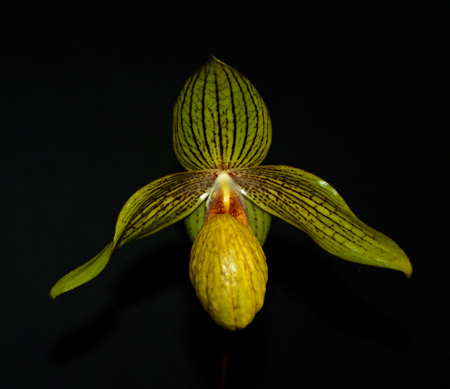L
Leo_5313
Guest
First bloom. I really like it.




Shape looks like Dollgoldi, but not the color -- at least, not ones I've seen.
This is Dollgoldi.
Most often yellow but Dollgoldi can be shades of green and even very brown.
I agree with the others. If it was Dollgoldi, it would not have the netting design on the petals. Paph. armeniacum does not have any markings on the petals of course and roth has stripes, not netting. However, malipoense does have a netting design on the petals. I'd like to see a photo of the staminode sheild.



You know Lance, assuming your information is correct, you've given me lots to ponder. Before this, of the two clones you've posted, I wouldn't dispute the validity of the more yellow one; but, I would dispute the more green one. Yet, you say that thay came from the same capsule.
Well I said they came from the same "flask". We have to assume that they came from the same capsule. In all fairness to 100% accuracy is it possible that a few seeds hitch hiked into the flask as stow-aways? I highly doubt it but anything is possible.
So (assuming that is correct), there seems to be far more variety in this grex than I had realized. I wonder if the capule that the two examples you show was the result of a selfing of Dollgoldi or from crossing armeniacum x roth?
It is from a remake of the original cross using the original parents. But the capsule was made by a different breeder. The original Dollgoldi capsule produced only about 12 seedlings, seven of which received awards.
The remake was done and more seedlings resulted and I would not be surprised if some chemical assist was used to increase seed count or germination, if that is even possible. If that were done then could it result in some genetic variation? This idea is only a possible excuse for the variation and not something that I have an info about.
Out of this remake I probably saw about 20 different clones bloom and most were the typical yellow form. But a few were on the green tint side and then the dark example that I posted above.
If it was from a selfing of Dollgoldi, there would be far more variety in the offspring. Still, where does that green colour come from? Hmmm?
Yes where?
As far as I know Dollgoldi has never been selfed or even used successfully as a parent?
Somewhere I have a picture of the original armeniacum used. It looks like it could be a polyploid to me which could also account for the variations?
(That is a question and not a statement of fact)
I had a look at the photos of my Dollgoldi that I posted on ST last year and found that even my flowers did have some netting in the petals. I'd forgotten that and remembered the bright yellow colour more. Now, you've made me want to buy at least one flask of Dollgoldi and one of HK and grow them all out to bloom and compare! There definitely is more investigation needed here....at least for me.
After they bloom side by side and there are some unusual ones people will tell you that you got some of them mixed up! :rollhappy:
In light of the information you've provided, the flower at the beginning of this thead could very well be Dollgoldi. I must look closely at the markings on roth petals sometime.
I'll see if I can fin a CU picture of a roth petal.
I guess the netting design comes from small markings on roth petals that are not so evident on the roth; but, come out in the hybrid Dollgoldi.
Probably the netting is a genetic link to some common ancestry.
Of course, all of this is assuming that the armeniacum used to make the Dollgoldi of this thead was in fact, a true armeniacum.
It was wild collected and as I recall has an FCC award. As I recall from the picture there is no excuse that the "netting" comes from it at all.
If it was Norito Hasegawa (which looks like a "butch" armeniacum; but, with netting on the petals and green colour in it's genes), that would make sense, considering the "look" of the flower on page 1.
I don't think so, but anything is possible. The breeders were trying to replicate the original success of the first Dollgoldi which at the time were worth big+++ money and only a few plants to go around.
I'd like to learn what others who have bloomed Dollgoldis have to say....
Me too! I'm always curious, that's why I threw out the info.


When you leave the country send these plants to me for safe-keeping, thanks!
Enter your email address to join: